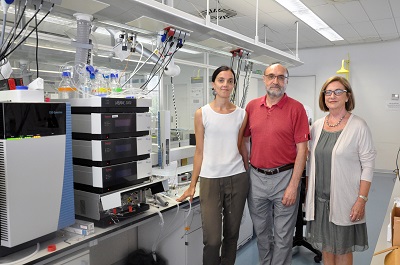An study, in which the Universitat de València and the Foundation for the Promotion of Health and Biomedical Research of the Valencian Community (FISABIO) have participated, concludes that the vegetables commercialised in the Valencian Community have low nitrate levels compared to other European countries. Moreover, the exposure of the consumers to nitrates for the consumption of vegetables is very low and it does not pose any noticeable health risk. The article, which has been published in the ‘Food and Chemical Toxicology’ magazine, has analysed the composition of seven species of vegetables.

The article, which has been published in the ‘Food and Chemical Toxicology’ magazine, has analysed the composition of seven species of vegetables.
The research, which determined the nitrate levels in vegetables and evaluated the health risks, stands that only 1.68% of the 533 studied samples exceed the limits of the European authorities and that the risk due to the presence of nitrates in vegetables is imperceptible. Among the analysed species, the chards, the fresh spinach and lettuce accumulate the highest nitrate levels whereas carrots have the lowest rate of this substance.
The article also calculates the exposure of the Valencian population to the potential risks of the excessively consumption of nitrate and it concludes that only 1.39% of the young people and 0.79% adults exceed the daily admissible amount of nitrates.
The research team is composed of Leyre Quijano, Vicent Yusà, Guillermina Font, Claudia McAllister, Concepción Torres and Olga Pardo, from the Departments of Preventive Medicine and Public Health, and the Department of Analytical chemistry of the Universitat de València; the FISABIO Research Area of Food Safety and the General Direction of Public Health of the Valencian Department for Universal and Public Health.
‘Nitrate is a compound that can been found naturally at the floor and that plants absorb. The intensive use as an agricultural fertilizer increases its presence in vegetables, especially the broad-leafed ones, which can accumulate greater levels of this substance in their leaves’, explains Guillermina Font.
Nitrate is not toxic in small doses, but several studies have related it to diseases such as Methemoglobinemia, a blood disorder. This is the reason why the European Commission has stablished nitrate maximum levels in food. Nevertheless, the Commission also insists on the fact that the advantages of eating vegetables are far greater than the risks derived from the presence of nitrates.
The article, which has been published in the ‘Food and Chemical Toxicology’ magazine, has analysed the composition of seven species of vegetables. The data shows that most vegetables that are commercialised in the Valencian markets present lower nitrate levels than the vegetables of other European markets. According to Vicent Yusà, this is related ‘to the weather conditions since a greater amount of sunshine and temperature tend to reduce the nitrate content in these plants’.
On a cross-country comparative basis, the exposure to nitrate is greater in Poland, France, New Zealand, Estonia or Ireland.
These results also indicate a decrease in the pollution by nitrate in the vegetables of the Valencian Community with regard to previous studies. ‘This reduction could be related to the appropriate application of the code of Good Agricultural Practices during the last years’, affirm the authors.
For this research, the nitrate levels in the vegetables have been analysed from data obtained from the monitoring programme of the Valencian Government, carried out between 2009 and 2013, in which a total of 533 specimens of seven species of different vegetables such as chard, lettuce, iceberg lettuce, spinach, potato, artichoke and carrot.
In addition to this, the daily nitrate consumption has been calculated based on the information provided by the Valencian Department for Health, through a study of consumption habits of the Valencian population, developed in 2010 and 2011, in which nearly 1,500 citizens took part.
Trajectory
Guillermina Source is professor and researcher of the Toxicology Area of the Department of Preventive Medicine of the Faculty of Pharmacy of the Universitat de València. Moreover, she is the director of the Master’s Degree in Food Quality and Safety. Her researches focus on the evaluation of the toxicological risk in food, especially when it comes to pesticide residues, veterinary drugs and mycotoxins.
On his part, Vicent Yusà is adjunct professor of the Department of Analytical Chemistry of the Universitat de València and researcher of the FISABIO Area of Food Safety, which is attached to the Valencian Department for Universal and Public Health.
Olga Pardo is researcher in the FISABIO Area of Food Safety and works as adjunct lecturer in the UV’s Department of Analytical Chemistry. She has developed her career in the Food Safety field, both in accredited laboratories by uploading the analytical methodologies and in the area of control, evaluation and risk priorisation resulting from the pollutants consumption through food.
Article:
Leyre Quijano, Vicent Yusà, Guillermina Font et al. (2016): «Risk assessment and monitoring programme of nitrates through vegetables in the Region of Valencia (Spain)», Food and Chemical Toxicology, 2016.
DOI https://doi.org/10.1016/j.fct.2016.12.010

.jpg)







